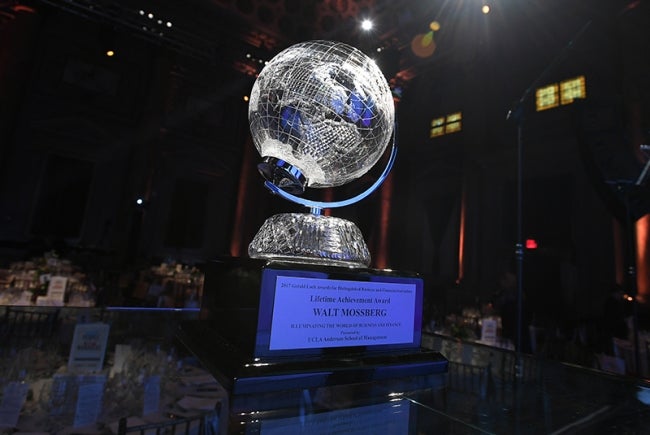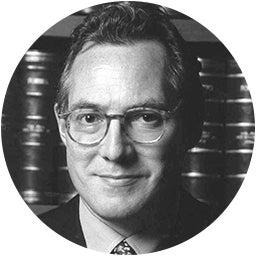Career Achievement Categories
Career Achievement Awards
2024 CALL FOR NOMINATIONS: March 5 - July 9
Submit Nominations NOW!
The Lifetime Achievement Award

The Lifetime Achievement Award recognizes exceptional career contributions in the field of business, financial and economic news. The recipient is selected by the Loeb Awards’ distinguished panel of final judges.
The hand-cut crystal globe presented to the Lifetime Achievement Award recipient is symbolic of the qualities honored by the Loeb Awards program: integrity, illumination, originality, clarity and coherence.
Lifetime Award Winners
2023
Stephen J. Adler, Reuters
2022
Michelle Singletary, The Washington Post
2021
Ellen Pollock, The New York Times
2020
Lionel Barber, Financial Times
2019
Martin Wolf, Financial Times
2018
Joann Lublin, The Wall Street Journal
2017
Walt Mossberg, The Verge & Recode
2016
Paul Ingrassia, Reuters
2015
James Grant, Grant's Interest Rate Observer
2014
James Flanigan, Los Angeles Times
2013
John Huey, TIME
2012
Jerry Seib, The Wall Street Journal
2011
Steven Pearlstein, The Washington Post
2010
Walt Bogdanich, The New York Times
2009
Bill Emmott, The Economist
2008
Daniel Hertzberg, The Wall Street Journal
2007
Matthew Winkler, Bloomberg News
2006
Myron Kandel, CNN
2005
Byron E. "Barney" Calame, The New York Times
2004
Louis Rukeyser, CNBC
2003
Floyd Norris, The New York Times
2002
Paul E. Steiger, The Wall Street Journal
2001
Allan Sloan, Newsweek
2000
Norman Pearlstine, TIME
1999
Stephen B. Shepard, Business Week
1998
Alen Abelson, Barron's
1997
Jane Bryant Quinn, Newsweek
1996
Marshall Loeb , Fortune/MONEY Magazine
1995
Leonard S. Silk (Posthumously), The New York Times
1994
James W. Michaels, Forbes
1993
Carol J. Loomis, Fortune
1992
Hobart Rowen, Washington Post
The Minard Editor Award

This award is dedicated to the memory of Lawrence Minard, former editor of Forbes Global, who had a long association with the Loeb Awards. An award winner in 1977, he became a preliminary judge in 1984 and joined the panel of final judges in 1987.
The award that bears his name recognizes the contributions of a business editor whose work does not receive a byline or whose face does not appear on the air for the work covered. The establishment of the award acknowledges an area of journalism that often goes unrecognized. In a posthumous tribute, Minard was the first recipient as part of the 2002 Loeb Awards. In 2003, it was given to Glenn Kramon, business editor of The New York Times; in 2004 to Michael Siconolfi, senior editor for financial investigative projects of The Wall Street Journal; in 2005 to Timothy K. Smith, assistant managing editor, Fortune; in 2006 to Ronald Henkoff, executive editor, Bloomberg News, and editor, Bloomberg Markets; in 2007 to Dan Kelly, news editor, Page One, The Wall Street Journal; in 2008 to Frank Comes, former assistant managing editor, BusinessWeek; in 2009 to Lawrence Ingrassia, business and financial editor, The New York Times; in 2010 to Alix Freedman, deputy managing editor, The Wall Street Journal; in 2011 to Hank Gilman, deputy managing editor, Fortune; in 2012 to Winnie O’Kelley, deputy business editor, The New York Times; in 2013 to Michael Williams, global enterprise editor, Reuters; in 2014 to John Brecher, executive editor for enterprise, Bloomberg News; in 2015 to Rebecca Blumenstein, deputy editor-in-chief, The Wall Street Journal; and in 2016 to Amy Stevens, Executive Editor of Professional News, Reuters.
Born Everett Lawrence Minard III, but known as Laury to his friends and colleagues, Minard began his 27-year career at Forbes as a reporter/researcher. He moved up the ranks to become managing editor of Forbes, a position he held for eight years, prior to joining Forbes Global as its founding editor in 1997.
Minard Award Winners
2023
Nancy Rivera Brooks, Los Angeles Times
2021
Garry D. Howard, American City Business Journals
2020
Alessandra Galloni, Reuters
2019
Michael Miller, The Wall Street Journal
2018
John Hillkirk, Kaiser Health News
2017
Nicholas Varchaver, Fortune
2016
Amy Stevens, Reuters
2015
Rebecca Blumenstein, The Wall Street Journal
2014
John Brecher, Bloomberg News
2013
Michael Williams, Reuters
2012
Winnie O'Kelley, The New York Times
2011
Hank Gilman, Fortune
2010
Alix Freedman, The Wall Street Journal
2009
Lawrence Ingrassia, The New York Times
2008
Dan Kelly, The Wall Street Journal
2007
Frank Comes, BusinessWeek
2006
Ronald Henkoff , Bloomberg
2005
Timothy K. Smith, Fortune
2004
Michael Siconolfi, The Wall Street Journal
2003
Glenn Kramon, The New York Times
2002
Lawrence Minard, Forbes